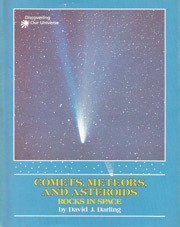COMETS, METEORS, AND ASTEROIDS: 3. Meteor Showers and Shooting Stars

Leonid meteor shower. This picture was taken in Arizona in November 1966.
Except for aircraft and satellites launched by humans from Earth, most objects in the night sky hardly appear to move at all. Even comets seem to crawl along at a snail's pace, barely changing position from one hour to the next.
But there's one kind of space object that flashes across the night sky faster than the eye can follow. For a second or two it blazes a thin white trail – and then it's gone. This object is a meteor or shooting star.
A meteor is a tiny piece of rock or dust that burns up as it speeds through the Earth's atmosphere. Far from being star-size, it may be no bigger than a grain of sand. It enters our atmosphere at a speed as high as 150,000 miles per hour (240,000 kilometers per hour). It is heated and begins to glow about 100 miles (160 kilometers) above the ground. Glowing white-hot, it lasts for a few more seconds while it plunges to a height of around 50 miles (80 kilometers). Then it is burned up and its remains drift in the air as the tiniest of dust fragments.
On any clear night, you may be able to spot as many as 10 meteors an hour flashing across the sky. Just gaze upwards and be patient! The meteors that you see will be just a few of the millions or so that burn up in our atmosphere every day.
In fact, the meteors that rush into Earth's atmosphere are just a few of the billions of METEOROIDS that go around the Sun. Meteoroid is the name given by scientists to any kind of small particle in space. A meteoroid becomes a meteor only when it enters the Earth's atmosphere.
Meteoroids come in sizes ranging from tiny grains too small to be see – micrometeroids – to chunks roughly the size of a grape. They form a great cloud, called the ZODIACAL CLOUD, that surrounds the Sun and through which the planets move. The zodiacal cloud probably weighs as much as 10 trillion tons.
Most of the meteoroids in the zodiacal cloud have come from comets. These bits and pieces were once stuck in the nuclei of comets before being shot out in their tails. After thousands or millions of years, the meteoroids drifted into a huge cloud. The zodiacal cloud is really nothing more than a graveyard for comets that broke up long ago.
But what about comets that are still alive, or that have died only recently? Their dust hasn't had time to drift into the zodiacal cloud. Where is it?
Here's where we return to find the ghost of Biela's Comet. Remember that the comet, itself, was never seen again after its return to the Sun, in two widely separated pieces in 1852. But in 1872, the Earth passed through a tremendous METEOR STORM at just the place where scientists would have expected to find the comet. What had happened?
Biela's Comet had completely broken up, setting free all the particles that had once formed its dirty snowball nucleus. Those particles were still clumped together around where the old comet had been. They were still moving around its old orbit. But now, they were separate meteoroids. In 1872, a large number of them smashed into the Earth's atmosphere and caused the Bielid meteor storm.
A meteor storm happens only rarely, when the Earth passes through a part of a comet's orbit where there is a lot of dust. The storm might come from the remains of a broken nucleus, as in the case of the Bielids. It could also be caused by a small piece of the comet that split off from the main part.
METEOR SHOWERS are much more common than storms. A number of them take place every year and, again, they are all known to be connected with comets.
As comets get older, dust from them gradually spreads out along their orbits. Dust from Encke's Comet, for example, now completely litters the path of the old, worn-out nucleus. Meteor showers happen when the Earth, on its yearly trek around the Sun, passes close by these comet orbits and sweeps up some of the dust they contain.
The Leonids, for instance, are meteors from a comet called Temple-Tuttle. They happen every year around November 17. The Perseids are from Comet Swift-Tuttle and can be seen between the end of July and the middle of August.
Weaker showers include the Taurids, from Encke's Comet, and the Bielids, or Andromedids, from Biela's Comet. In each case, the meteor shower is named after the group of stars, or constellation, in the part of the sky from which it seems to come.
Sometimes, one of the famous yearly showers will turn into a storm. Such a storm happened last just after dawn on November 17, 1966, over the western United States. Meteors from the Leonid shower started falling at the rate of 40 a second – or 144,000 an hour! Normally, the heaviest shower is the Perseids with almost 70 meteors an hour. Those who were lucky enough to see the 1966 Leonids witnessed one of the heaviest meteor storms on record.

